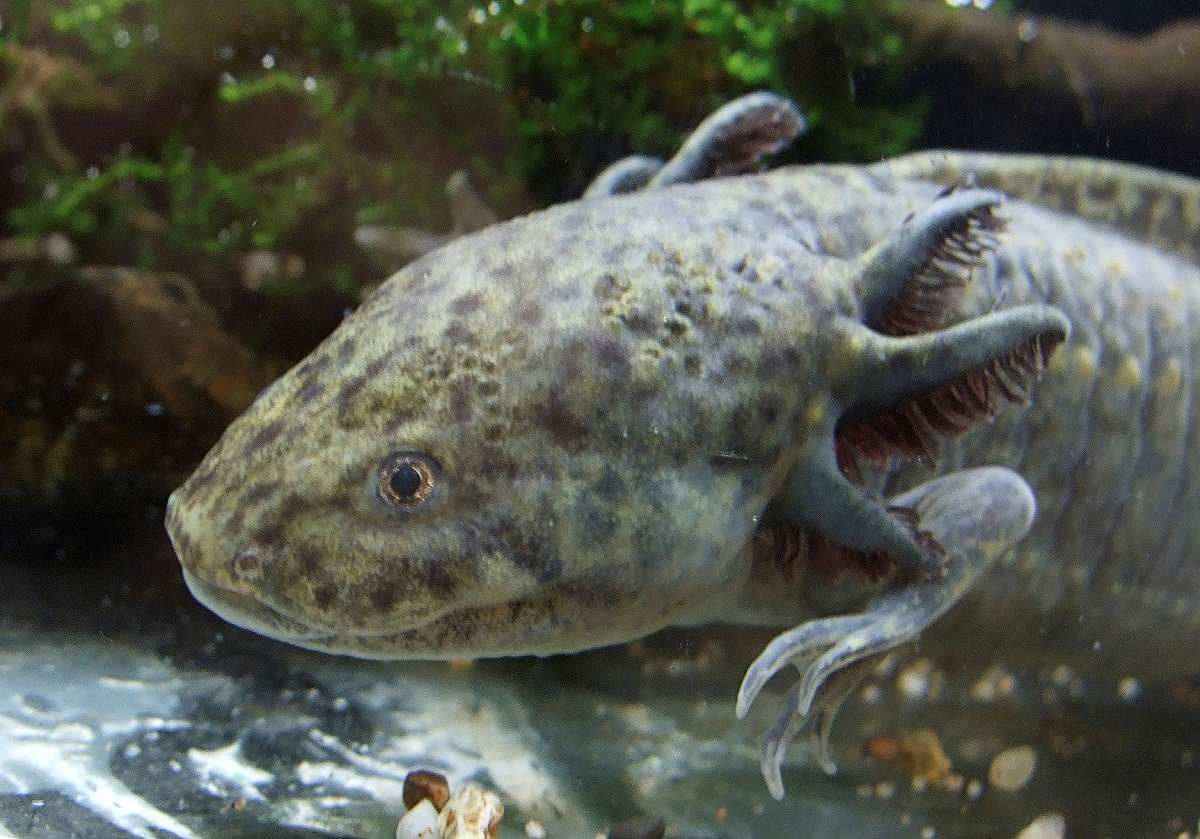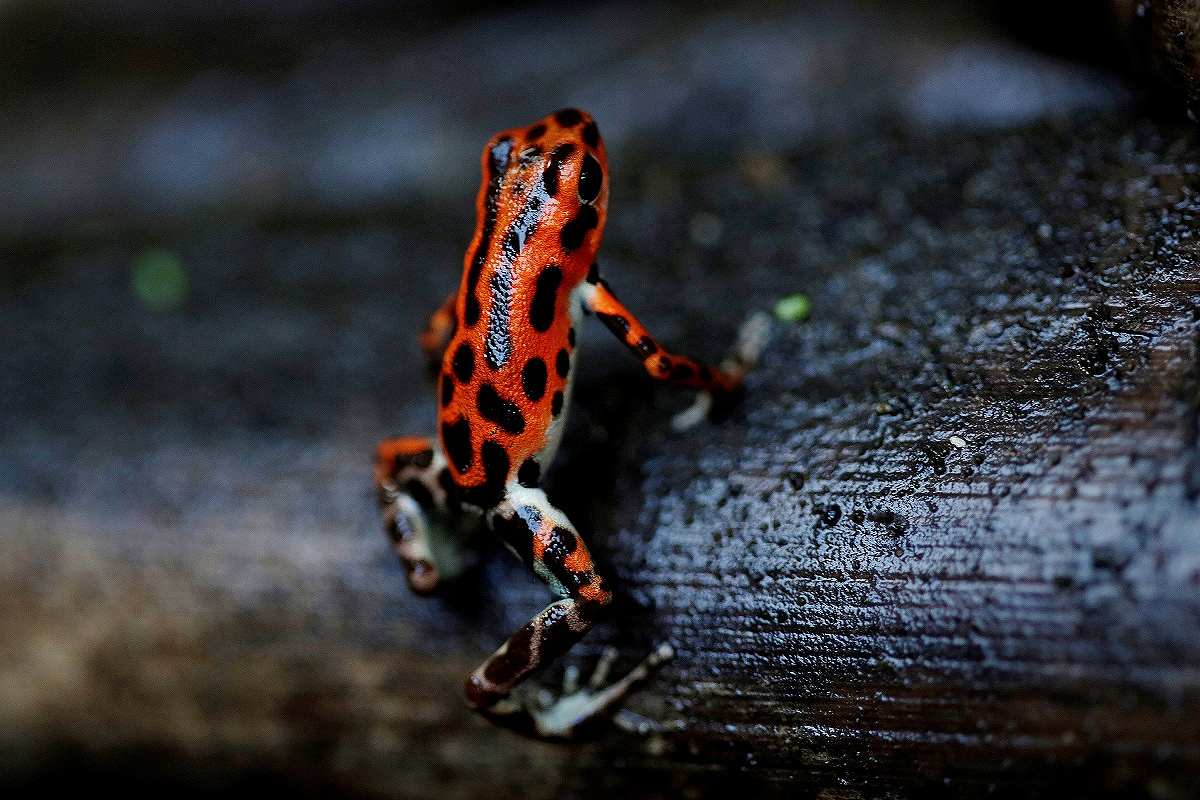
Forest green treefrogs are seen laying eggs on a branch in Kawauchi, Fukushima Prefecture, in June 2012.
17:03 JST, October 12, 2023
WASHINGTON (Reuters) — Earth’s amphibians — from the thorny spike-thumb frog to the red knobby newt, West African giant squeaker, ornate tree frog and fire salamander — are being pushed closer to the brink due to habitat destruction, disease and climate change, with 41% of species now threatened with extinction.

A rare axolotl, a type of salamander that uniquely spends its whole life in its larval form, is seen inside an aquarium in Kuala Lumpur in November 2008.
Those are the findings of a new global assessment unveiled by conservationists on Oct. 4 of 8,011 species of amphibians — vertebrates that inhabit both aquatic and terrestrial habitats. The state of the world’s amphibians is more dire now than at the time of the first such assessment in 2004, when 39% of species were threatened, according to updated data for that period.
Human activities and climate change have upset our planet’s delicate balance, to the detriment of its flora and fauna. Amphibians are in the worst shape among vertebrates — with 27% of mammals, 21% of reptiles and 13% of birds found to be threatened with extinction in separate assessments.
The amphibian assessment involved a worldwide collaboration by 1,000-plus experts. Finding a species to be threatened with extinction means it has been evaluated as “critically endangered,” “endangered” or “vulnerable” on the International Union for Conservation of Nature (IUCN) “red list” of threatened species, the global authority on wildlife extinction risk.
“For the most part, protected area identification and conservation planning is geared toward the needs of mammals and birds. Amphibians are falling through the cracks,” said conservationist Jennifer Luedtke of the Texas-based global nonprofit Re:wild, co-coordinator of the IUCN Amphibian Specialist Group’s red list authority and lead author of the study published in the journal Nature.
Amphibians first appeared more than 300 million years ago. Three orders of amphibians exist today: salamanders and newts (60% threatened with extinction); frogs and toads (39%); and the limbless and serpentine caecilians (16%). Since 2004, 306 species have crept closer to extinction, the study found.

A Trachycephalus venulosus frog is seen at a terrarium in Caracas in November 2015.

A strawberry poison dart frog (Oophaga pumilio) is seen on the outskirts of Panama City in January 2015.
“What is needed now is a global movement to catalyze the recovery of the world’s amphibians,” Re:wild conservationist and study coauthor Kelsey Neam said.
The researchers identified four amphibian species — a frog from Australia, a frog from Guatemala, a salamander from Guatemala and a toad from Costa Rica — that have disappeared since 2004. They also listed 185 species as “possibly extinct,” with no known surviving population.
Habitat destruction and degradation, caused mostly by animal agriculture and crops, remained the most common danger, affecting 93% of the threatened amphibian species. But a growing proportion of species was being imperiled by disease and climate change, the researchers found.
“Amphibians are particularly sensitive to changes in their environment, in part because they breathe through their skin,” Neam said.
“So the effects of climate change — increased frequency and intensity of extreme weather events, changes in moisture and temperature, sea-level rise and fires — can result in the loss of key breeding sites, increased mortality, habitat degradation, and habitat shifts that make it harder for amphibians to find suitable places to live,” Neam added.
While an amphibian pandemic involving a fungal pathogen that causes the disease chytridiomycosis has waned, there is fresh concern that another fungal pathogen seen in Asia and Europe may enter the Americas. The study also cited ongoing threats from the animal trade and human hunting for food.
The heaviest concentrations of threatened amphibians were found to be in the Caribbean islands, Mexico and Central America, the tropical Andes region, India, Sri Lanka, Cameroon, Nigeria and Madagascar.
“Amphibians have evolved into an incredible diversity of sizes, colors and behaviors. They can be as tiny as a common housefly — like the Macaya breast-spot frog — and as long as a cow — like the Chinese giant salamander,” Neam said.
“Amphibians are our allies in understanding the health of our planet,” Luedtke said. “When we protect and recover amphibians, we protect and restore terrestrial and aquatic ecosystems, we safeguard the genetic diversity of our planet, and we invest in a future in which all life — including human life — thrives.”

A tree frog at London Zoo in January 2012.
"Science & Nature" POPULAR ARTICLE
-

Genome Study Reveals Milestone in History of Cat Domestication
-

Big Leap in Quest to Get to Bottom of Climate Ice Mystery
-

Japan Set to Participate in EU’s R&D Framework, Aims to Boost Cooperation in Tech, Energy
-

Paws on Parade: Nairobi’s Dogs Dazzle at ‘Pawchella’
-

Japan’s H3 Rocket Failed in Latest Launch, Says Official
JN ACCESS RANKING
-

Tokyo Economic Security Forum to Hold Inaugural Meeting Amid Tense Global Environment
-

Keidanren Chairman Yoshinobu Tsutsui Visits Kashiwazaki-Kariwa Nuclear Power Plant; Inspects New Emergency Safety System
-

Imports of Rare Earths from China Facing Delays, May Be Caused by Deterioration of Japan-China Relations
-

University of Tokyo Professor Discusses Japanese Economic Security in Interview Ahead of Forum
-

Japan Pulls out of Vietnam Nuclear Project, Complicating Hanoi’s Power Plans























